第十五章 纳米复合材料
纳米复合材料的介绍

纳米复合材料的介绍纳米复合材料是一种由纳米尺度的颗粒或纤维与基体材料相结合而形成的新型材料。
它具有独特的结构和性能,广泛应用于诸多领域,如材料科学、能源、电子、医药等。
本文将从纳米复合材料的定义、制备方法、特点和应用领域等方面进行介绍。
纳米复合材料是由纳米颗粒或纤维与基体材料相结合而形成的材料。
纳米颗粒的尺寸通常在1到100纳米之间,纳米纤维的直径通常在1到100纳米之间。
与传统的材料相比,纳米复合材料具有更大的比表面积和更多的界面,这使得其具有独特的物理、化学和力学性能。
纳米复合材料的制备方法多种多样,常见的包括溶胶-凝胶法、化学气相沉积法、溶液法、电化学沉积法等。
这些方法可以根据不同的需求和材料特性选择合适的制备方法。
例如,溶液法可以用于制备纳米颗粒的复合材料,而化学气相沉积法则适用于制备纳米纤维的复合材料。
纳米复合材料具有许多独特的特点。
首先,由于其纳米尺度的结构,纳米复合材料具有更好的机械强度和硬度。
其次,纳米颗粒或纤维的存在可以增强材料的导电性、导热性和光学性能。
此外,纳米复合材料还具有较好的化学稳定性和抗腐蚀性能。
这些特点使得纳米复合材料在材料科学和工程领域具有广阔的应用前景。
纳米复合材料在诸多领域有着广泛的应用。
在材料科学领域,纳米复合材料可以用于制备高性能的材料,如高强度、高导电性的复合材料。
在能源领域,纳米复合材料可以应用于太阳能电池、锂离子电池等领域,提高能源的转化效率和储存能力。
在电子领域,纳米复合材料可以用于制备高性能的电子器件,如柔性显示屏和传感器等。
在医药领域,纳米复合材料可以用于制备药物载体,实现药物的靶向输送和控释。
此外,纳米复合材料还可以应用于环境保护、食品包装等领域。
纳米复合材料是一种具有独特结构和性能的新型材料。
通过纳米颗粒或纤维与基体材料的结合,纳米复合材料展现出许多优异的特点,应用领域广泛。
随着纳米科技的不断发展,纳米复合材料将在各个领域发挥更加重要的作用,为人类社会的进步和发展做出更大的贡献。
纳米复合材料的制备

纳米复合材料的制备纳米复合材料的制备,听起来就像是高深莫测的东西,仿佛是某个科学家在实验室里搞的神秘实验,搞得一脸严肃,黑框眼镜,白大褂。
但实际上,说白了,纳米复合材料其实就是通过把不同的材料融合在一起,得到一种更强、更好用的材料。
比如说,我们平常见到的塑料,可能就通过加入一些特别的物质,变得更耐用、轻便,甚至更抗高温,拿起来不再像纸一样容易破碎。
而这个“特别的物质”就是纳米级的材料,可能你想象不出来,但其实它们的尺寸极小,比我们常说的细胞还要小,甚至比病毒还要小——这真是微观世界的魔法,嘿!没错,正是这种超微小的物质,给了复合材料强大的力量。
纳米复合材料怎么制备呢?说起来吧,过程其实不复杂,但可得讲究点。
材料得选好,这个就像挑菜一样,挑到合适的才好做大餐。
比如说,有些复合材料需要高分子材料做基底,再通过加入一些纳米颗粒,比如纳米碳管、纳米硅、纳米氧化铝这些,慢慢调配,最终形成我们需要的样子。
就像做菜,你要选对主料和配料,再用对调料,才能做出一道色香味俱全的好菜。
嘿,别小看了这些“配料”,它们在材料里可发挥着巨大的作用,起到增强、加固的效果。
你想,原本有些材料就很脆,轻轻一碰就碎了,但加上这些纳米级的小颗粒后,硬度一下子提升,就像原本的纸壳子变成了铁板一样,硬朗又耐用。
再说了,制备的方式也是有很多种的。
最常见的就是物理法和化学法,听起来可能有点头大,但其实就是两种不同的“方式”,一个是靠物理手段,一个是靠化学反应,给纳米颗粒加进材料里。
有时候用物理法就像是在大锅里加热煮东西,纳米颗粒通过高温融入材料,合成一个更加结实的复合材料。
而化学法嘛,稍微复杂一点,就像是调味品一样,加点化学反应,帮助颗粒和基体形成更加紧密的结合。
这两种方法各有千秋,看你要做什么类型的复合材料。
你还得根据不同的材料,调整一下温度、压力,甚至时间,真是需要点技术含量的。
不过,别担心,这一切都可以通过控制条件来实现。
说到这里,你可能会想,这些纳米颗粒真的那么神奇吗?那得看你怎么用啦。
纳米复合材料范文

纳米复合材料范文纳米复合材料的制备方法多种多样,包括溶液法、凝胶法、化学气相沉积等。
其中,溶液法是一种常用的制备方法,其步骤主要包括纳米颗粒的制备和纳米颗粒与基体材料的混合。
制备纳米颗粒的方法包括溶胶凝胶法、球磨法、热溶胶法等。
然后通过将纳米颗粒与基体材料进行混合,形成纳米复合材料。
通过在复合材料中引入纳米颗粒,可以改善材料的机械性能和热传导性能。
例如,将纳米颗粒引入到金属基体中可以显著提高材料的强度和硬度;将纳米颗粒引入到聚合物基体中可以增加材料的韧性和耐磨性。
此外,纳米颗粒的高比表面积和尺寸效应也可以改善材料的光学和电学性能。
纳米复合材料的应用领域广泛。
在汽车工业中,纳米复合材料可以用于制造轻量化零部件,提高汽车的燃油效率和减少尾气排放。
在航空航天领域,纳米复合材料可以用于制造耐高温材料和轻量化结构材料,提高飞机的性能和降低重量。
在电子技术领域,纳米复合材料可以用于制造高性能的半导体器件和导电粘合剂。
在能源储存和转换领域,纳米复合材料可以用于制造高效的太阳能电池和储能材料。
然而,纳米复合材料也面临一些挑战和问题。
首先,纳米颗粒的制备和纳米复合材料的制备需要精确的控制和复杂的操作,增加了材料的制备成本和工艺复杂性。
其次,纳米颗粒的分散性和稳定性对纳米复合材料的性能有重要影响,而纳米颗粒的分散和稳定性往往是一个挑战。
此外,由于纳米颗粒的尺寸效应,纳米复合材料的性能通常会受到尺寸效应的影响,这需要更深入的研究和理解。
综上所述,纳米复合材料具有独特的特性和广泛的应用潜力。
通过精确控制纳米颗粒的制备和纳米复合材料的制备过程,可以获得具有优异性能的纳米复合材料。
随着纳米技术的不断发展,纳米复合材料将在许多领域中发挥越来越重要的作用。
纳米复合材料的应用

率。
提高循环寿命
纳米复合材料可以提高锂离子电 池的循环寿命,使其在多次充放
电过程中保持稳定的性能。
提高安全性
纳米复合材料可以改善锂离子电 池的安全性能,降低其燃烧和爆
炸的风险。
超级电容器
1 2
提高储能密度
纳米复合材料可以作为超级电容器的电极材料, 提高其储能密度,从而增加电容器的储能能力和 输出功率。
纳米复合材料的应用
目录
• 纳米复合材料的简介 • 纳米复合材料在能源领域的应用 • 纳米复合材料在医疗领域的应用 • 纳米复合材料在环保领域的应用 • 纳米复合材料在其他领域的应用
01 纳米复合材料的简介
定义与特性
定义
纳米复合材料是由两种或两种以 上材料组成,其中一种材料为纳 米尺度(1-100纳米)的复合材 料。
提高充放电速度
纳米复合材料可以提高超级电容器的充放电速度, 使其在短时间内完成充电和放电过程。
3
提高稳定性
纳米复合材料可以提高超级电容器的稳定性,使 其在长时间使用过程中保持稳定的性能。
03 纳米复合材料在医疗领域 的应用
药物输送
利用纳米复合材料作为药物载体, 能够实现药物的精准输送和靶向 释放,提高药物的疗效并降低副
04 纳米复合材料在环保领域 的应用
水处理
纳米滤膜
01
利用纳米滤膜技术,可以有效去除水中的细菌、病毒、重金属
离子等有害物质,提高水质。
纳米絮凝剂
02
利用纳米絮凝剂的特性,可以有效吸附水中的悬浮物和有机物,
使水质变得清澈透明。
纳米光催化剂
纳米复合材料的制备及其性能研究

纳米复合材料的制备及其性能研究纳米复合材料是一种新型的材料,由于其独特的性能和广泛的应用前景,在材料科学领域引起了极大的关注。
本文将介绍纳米复合材料的制备方法以及其在不同领域中的性能研究。
一、纳米复合材料的制备方法制备纳米复合材料的方法有很多种,包括溶液法、化学气相沉积法、溶胶-凝胶法等。
其中,溶液法是一种常用且简便的方法。
通过将纳米材料或其前体溶解在溶剂中,然后加入适当的基体材料,并通过搅拌或超声处理使其充分混合,最后通过蒸发溶剂或其他方法得到纳米复合材料。
二、纳米复合材料的性能研究纳米复合材料具有许多优异的性能,如高强度、高韧性、热稳定性等,对于材料的性能研究具有重要意义。
以下将分别从力学性能、电学性能和光学性能方面介绍。
1.力学性能纳米复合材料的力学性能主要包括硬度、强度和断裂韧性等指标。
在纳米尺度下,由于纳米颗粒的存在,可以有效地提高材料的硬度和强度。
此外,纳米材料的增加还可以提高复合材料的断裂韧性,使其在受力时具有更好的抗拉伸和抗屈曲性能。
2.电学性能纳米复合材料在电学性能方面也有独特的优势。
纳米颗粒具有较大的比表面积,可以提高电学导率。
此外,通过控制纳米颗粒的尺寸和形状,还可以调控材料的电阻率和介电性能。
这些特性使纳米复合材料在柔性电子器件、导电材料等方面具有广阔的应用前景。
3.光学性能纳米复合材料在光学性能方面也表现出不同于传统材料的特点。
纳米颗粒在光学中呈现出量子尺寸效应,其光学性质与粒子的尺寸和形状密切相关。
通过调控纳米颗粒的尺寸和形状,可以实现材料的光学增益和频率调制等功能,广泛应用于光电子器件、传感器等领域。
三、纳米复合材料的应用前景纳米复合材料由于其独特的性能,在许多领域具有广阔的应用前景。
以下将介绍几个常见的应用领域。
1.医疗领域纳米复合材料在医疗领域中具有广泛的应用,例如用于制造可降解的植入材料,用于治疗癌症的纳米药物载体等。
纳米颗粒的小尺寸和高比表面积可以提高植入材料的生物相容性和降解性能,同时也可以提高药物的载荷效率和靶向性。
纳米复合材料的塑型研究

纳米复合材料的塑型研究一、纳米复合材料概述纳米复合材料是一类具有独特物理、化学和机械性能的新型材料,它们通过将纳米尺寸的填料(如纳米颗粒、纳米线、纳米片等)分散在基体材料中制备而成。
这些纳米填料的加入显著提高了材料的性能,如强度、韧性、导电性、导热性等,使其在航空航天、生物医学、电子信息、能源存储等领域展现出广泛的应用前景。
1.1 纳米复合材料的组成纳米复合材料由两部分组成:基体材料和纳米填料。
基体材料可以是金属、陶瓷、聚合物等,而纳米填料则包括碳纳米管、石墨烯、氧化铁、二氧化钛等。
纳米填料的尺寸通常在1-100纳米范围内,具有极高的比表面积和独特的量子效应。
1.2 纳米复合材料的制备方法纳米复合材料的制备方法多种多样,包括机械混合法、原位聚合法、溶胶-凝胶法、化学气相沉积法等。
这些方法各有优缺点,选择合适的制备方法对于获得高性能的纳米复合材料至关重要。
1.3 纳米复合材料的性能特点纳米复合材料的性能特点主要体现在以下几个方面:- 高强度:由于纳米填料与基体材料之间的界面结合力强,纳米复合材料通常具有比传统材料更高的强度。
- 高韧性:纳米填料的存在可以有效地吸收和分散材料内部的应力,提高材料的韧性。
- 优异的导电性:某些纳米填料如碳纳米管和石墨烯具有优异的导电性,可以显著提高复合材料的电导率。
- 良好的导热性:纳米填料如金属纳米颗粒和碳纳米管具有高的热导率,可以提高复合材料的热传导性能。
二、纳米复合材料的塑型研究塑型是材料加工的重要环节,对于纳米复合材料而言,塑型过程不仅影响材料的微观结构,也直接关系到其宏观性能。
因此,对纳米复合材料的塑型研究具有重要意义。
2.1 纳米复合材料塑型过程中的挑战纳米复合材料在塑型过程中面临诸多挑战,主要包括:- 纳米填料的分散性:纳米填料在基体中的分散不均匀会影响材料的性能。
- 界面结合力:纳米填料与基体材料之间的界面结合力不足可能导致材料性能下降。
- 塑型过程中的热稳定性:纳米复合材料在高温塑型过程中可能会出现热降解现象。
纳米复合材料的结构和性能 ppt课件
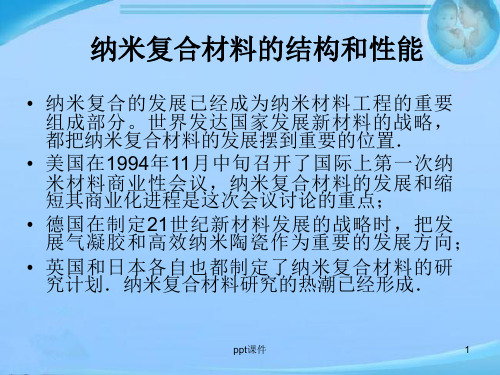
ppt课件
39
仿生纳米材料
ppt课件
40
仿生纳米材料
• 生物体的壳为纳 米结构,有机体 作为结构导向剂, 基本单元为晶态 的CaCO3 和非 晶态的SiO2 组 成。
ppt课件
41
趋磁性细菌
• 磁性导航:从富氧水 的环境(对其有毒害) 迁移到富营养的沉积 物中。 • 北半球北极运动 • 南半球南极运动
ppt课件
28
超微型纳米阵列激光器
• 纳米阵列激光器是 21 世纪超微型激光器 重要的发展方向.回顾激光器发展的历 史,大致可以分为3个阶段:自从20世纪 60 年代激光被发现以来, 1962 年就制成 了第一个半导体激光器.几十年来,人 们主要围绕三方面问题来不断改进激光 器.一是进一步增加激光强度,二是降 低产生激光的电流密度,三是提高热稳 定性.
ppt课件 37
超高灵敏度电探测器和高密度电接线头
• 痕量电荷如何探测一直是人们关心的问 题,纳米结构电极组装体可以把目前电 分析探测极限降低3个数量级,即探测灵 敏度提高了3个数量级.
ppt课件
38
纳米结构离子分离器
• 离子分离器在电化学和再生电池等方面 有着重要的作用,提高离子分离效率一 直是人们追求的目标,纳米结构为解决 这个问题提供了新的途径.近年来已有 报道,利用纳米孔洞阵列模板合成 Au 纳 米管阵列,可以作为高效离子分离器 。
• (2)太阳能电池 太阳能的利用是21世纪能 源开发的重点,这不仅是因为太阳能取 之不尽,用之不绝,更重要的是因为它 对环境没有污染,是理想的清洁能源。 世界各国都制订了太阳能应用的规划, 研制高效太阳能电池是太阳能利用的一 个重要方面.纳米材料和纳米结构作为 太阳能转化材料已引起人们高度的重 视. 24 ppt课件
纳米复合材料的结构和性能

可用于磁热治疗、磁热发电等领域。
04
CATALOGUE
纳米复合材料的应用
电子信息领域
1 2 3
电子封装材料
纳米复合材料具有优异的热导率和绝缘性能,可 用于电子器件的封装,提高产品的可靠性和稳定 性。
电子元件制造
纳米复合材料可应用于电子元件的制造,如电磁 波吸收材料、电磁屏蔽材料等,提高电子产品的 性能。
环境领域
空气净化
纳米复合材料可用于空气净化器的滤芯材料,吸附和分解空气中 的有害物质,提高室内空气质量。
水处理
纳米复合材料可用于水处理中的吸附剂和催化剂,去除水中的有 害物质和重金属离子。
环保材料
纳米复合材料可用于环保材料的制造,如可降解塑料、绿色包装 材料等,降低环境污染。
生物医疗领域
生物成像
高强度和硬度
纳米复合材料由于其纳米尺度的 增强相,具有高强度和硬度的特 性,能够承受更大的压力和抵抗
更高的温度。
良好的韧性
通过优化增强相的尺寸、形状和分 布,纳米复合材料可以在保持高强 度的同时具备良好的韧性,提高材 料的抗冲击性能。
抗疲劳性能
由于增强相的纳米尺度效应,纳米 复合材料的抗疲劳性能得到显著提 高,能够承受更多的循环载荷。
光学性能
良好的光学透性
01
通过选择透明基体和合适的填料,纳米复合材料可以表现出良
好的光学透性,用于制造光学器件、窗口材料等。
特殊的光学性能
02
一些纳米复合材料具有特殊的光学性能,如光致变色、荧光等
,可用于制造显示器、照明器件等。
光热转换性能
03
一些纳米复合材料可以将光能转换为热能,用于光热治疗、光
热发电等领域。
《纳米复合材料》PPT课件

(1)热压烧结 热等静压(HIP)也属于热压烧结的一种。它是用金属箔代 替橡胶模具,用气体代替液体,使金属箔内的陶瓷基体 和纳米增强体混合粉末均匀受压。通常所用气体为氦气、 氩气等惰性气体,金属箔为低碳钢、镍、钼等。一热等静压烧结。 与一般热压烧结法相比,HIP法使混合物料受到各向同 性的压力,使显微结构均匀;另外HIP法施加压力高,在 较低温度下即可烧结。
(1)高强度、高韧性
陶瓷基纳米复合材料,特别是氧化物系陶瓷基纳米复合材料力学 性能的明显改善大致可归结如下: (1)纳米级弥散相抑制了氧化物基体晶粒生长和减轻了晶粒的异常长大, 起到细晶强化作用。 (2)在弥散相内或弥散相周围存在高的局部应力,这种应力是基体和弥 散相之间热膨胀失配而产生的,使冷却期间产生位错。纳米级粒子钉 扎或进入位错区使基体晶粒内形成亚晶界,使基体晶粒再细化而起增 强作用。 (3)纳米级粒子周围的局部拉伸应力引起穿晶断裂,并由于硬粒子对裂 纹尖端的反射作用而产生韧化。破坏模式从穿晶和晶间到单纯晶间断 裂,晶界相(通常约10%体积的无定形相)的改变和对高温力学性能影 响的减小,使高温力学性能获得明显改善。 (4)纳米级粒子在高温牵制位错运动,从而也能使高温力学性能获得明 显改善。
基体中的显微缺陷及晶须密集处同样存在较大内应力和孔 穴的积累而形成的疲劳裂纹。 疲劳裂纹的扩展是由于裂纹前沿所形成的微孔的连接而引 起的。当裂纹的扩展遇到SiC微粒或晶须时,裂纹扩展会停 止,而等待附近其他微孔的积累、连接,再引发裂纹形成 及扩展。 含有复合基体的SiCw增强纳米复合材料,其裂纹的形成及 扩展受基体韧化的影响,因而提高了其疲劳性能。
3 抗蠕变、抗疲劳性好
颗粒增强的纳米复合材料的最小蠕变速率要比基体合金低 2个数量级;在相同蠕变速率下,颗粒增强时可比未增强 基体的蠕变应力增加1倍左右,即纳米复合材料所承受的 应力提高了1倍。 晶须增强时又要比颗粒增强时抗蠕变性能更好。 一般纳米复合材料的应力指数n明显高于基体。基体的n约 为4—5,而纳米复合材料的n约为9—20。这反映了纳米 复合材料的蠕变速率对应力的敏感性大。 颗粒和晶须增强金属基纳米复合材料的疲劳强度和疲劳寿 命一般比基体金属高。纳米复合材料疲劳性能的提高可能 与其强度和刚度的提高有关。
纳米复合材料的报告
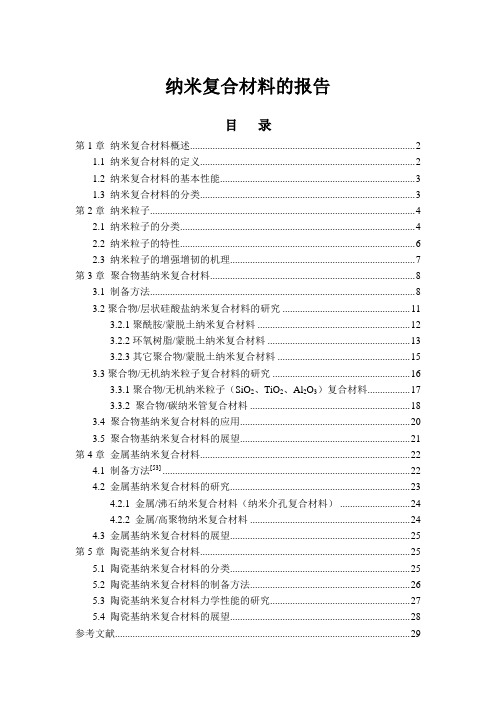
纳米复合材料的报告目录第1章纳米复合材料概述 (2)1.1 纳米复合材料的定义 (2)1.2 纳米复合材料的基本性能 (3)1.3 纳米复合材料的分类 (3)第2章纳米粒子 (4)2.1 纳米粒子的分类 (4)2.2 纳米粒子的特性 (6)2.3 纳米粒子的增强增韧的机理 (7)第3章聚合物基纳米复合材料 (8)3.1 制备方法 (8)3.2聚合物/层状硅酸盐纳米复合材料的研究 (11)3.2.1聚酰胺/蒙脱土纳米复合材料 (12)3.2.2环氧树脂/蒙脱土纳米复合材料 (13)3.2.3其它聚合物/蒙脱土纳米复合材料 (15)3.3聚合物/无机纳米粒子复合材料的研究 (16)3.3.1聚合物/无机纳米粒子(SiO2、TiO2、Al2O3)复合材料 (17)3.3.2 聚合物/碳纳米管复合材料 (18)3.4 聚合物基纳米复合材料的应用 (20)3.5 聚合物基纳米复合材料的展望 (21)第4章金属基纳米复合材料 (22)4.1 制备方法[53] (22)4.2 金属基纳米复合材料的研究 (23)4.2.1 金属/沸石纳米复合材料(纳米介孔复合材料) (24)4.2.2 金属/高聚物纳米复合材料 (24)4.3 金属基纳米复合材料的展望 (25)第5章陶瓷基纳米复合材料 (25)5.1 陶瓷基纳米复合材料的分类 (25)5.2 陶瓷基纳米复合材料的制备方法 (26)5.3 陶瓷基纳米复合材料力学性能的研究 (27)5.4 陶瓷基纳米复合材料的展望 (28)参考文献 (29)1.1 纳米复合材料的定义20世纪60年代由于高技术的发展,各个行业对材料性能的要求日益提高,单一材料很难满足性能的综合要求和高指标要求。
复合材料因具有结构可设计性的特点受到发达国家的重视,因而发展很快,已开发出许多性能优良的先进复合材料。
现在关于各种复合材料的基础研究也正在深入开展,有人预言,21世纪将是复合材料的时代。
根据国际标准化组织(International Organization for Standardization, ISO)为复合材料所下的定义,复合材料(Composite materials)是由两种或两种以上物理和化学性质不同的物质组合而成的一种多相固体材料。
纳米复合材料
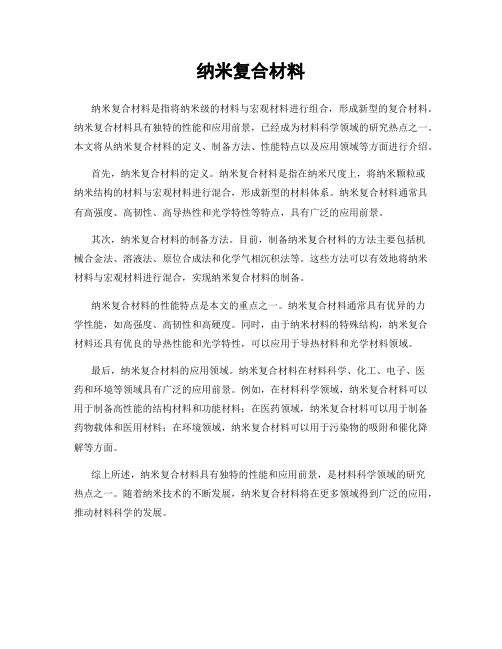
纳米复合材料
纳米复合材料是指将纳米级的材料与宏观材料进行组合,形成新型的复合材料。
纳米复合材料具有独特的性能和应用前景,已经成为材料科学领域的研究热点之一。
本文将从纳米复合材料的定义、制备方法、性能特点以及应用领域等方面进行介绍。
首先,纳米复合材料的定义。
纳米复合材料是指在纳米尺度上,将纳米颗粒或
纳米结构的材料与宏观材料进行混合,形成新型的材料体系。
纳米复合材料通常具有高强度、高韧性、高导热性和光学特性等特点,具有广泛的应用前景。
其次,纳米复合材料的制备方法。
目前,制备纳米复合材料的方法主要包括机
械合金法、溶液法、原位合成法和化学气相沉积法等。
这些方法可以有效地将纳米材料与宏观材料进行混合,实现纳米复合材料的制备。
纳米复合材料的性能特点是本文的重点之一。
纳米复合材料通常具有优异的力
学性能,如高强度、高韧性和高硬度。
同时,由于纳米材料的特殊结构,纳米复合材料还具有优良的导热性能和光学特性,可以应用于导热材料和光学材料领域。
最后,纳米复合材料的应用领域。
纳米复合材料在材料科学、化工、电子、医
药和环境等领域具有广泛的应用前景。
例如,在材料科学领域,纳米复合材料可以用于制备高性能的结构材料和功能材料;在医药领域,纳米复合材料可以用于制备药物载体和医用材料;在环境领域,纳米复合材料可以用于污染物的吸附和催化降解等方面。
综上所述,纳米复合材料具有独特的性能和应用前景,是材料科学领域的研究
热点之一。
随着纳米技术的不断发展,纳米复合材料将在更多领域得到广泛的应用,推动材料科学的发展。
材料学中的纳米复合材料

材料学中的纳米复合材料纳米科技是一个以纳米尺度为基础的技术领域。
纳米技术运用了物理、化学、生物和工程学等多种学科的原理和方法,研究和制造功能材料和器件。
随着纳米科技的发展,纳米复合材料也引起了越来越多的关注。
本文将探讨材料学中的纳米复合材料。
1. 纳米复合材料的定义纳米复合材料是由两种或两种以上材料通过纳米级的物理或化学交互作用,形成的新型复合材料。
与传统复合材料相比,纳米复合材料具有更高的强度、硬度、韧性和耐磨性,同时也具有更好的导热性、导电性、光学性、生物相容性和防腐蚀性等性能。
由于纳米复合材料的制造技术不断发展,它们在各种领域中有着广泛的应用,如生物医学、能源、环境保护和航空航天等领域。
2. 纳米复合材料的制备方法纳米复合材料的制备方法主要有物理法、化学法和生物法。
物理法主要包括溶胶-凝胶法、电沉积法、机械合金化法和热喷涂法等。
化学法主要包括水热法、溶剂热法、高分子包埋法和微乳化法等。
生物法主要包括生物矿化法和生物合成法等。
每种制备方法都有其优缺点和适用范围。
选择合适的制备方法可以制备出高性能的纳米复合材料。
3. 纳米复合材料的应用领域纳米复合材料的应用领域非常广泛。
在生物医学领域,纳米复合材料可以用于药物传递、细胞成像和组织工程等应用。
在能源领域,纳米复合材料可以应用于太阳能电池、超级电容器和燃料电池等。
在环境保护领域,纳米复合材料可以用于污染物检测、废水处理和污染物吸附等。
在航空航天领域,纳米复合材料可以用于航空器制造、防护材料和空气净化等。
4. 未来发展方向纳米复合材料具有广泛的应用前景,但是也面临着一些挑战。
其中最大的挑战是提高制备工艺和控制材料结构的方法。
未来的发展主要需要集成先进的技术和方法来研究材料的性能和微观结构。
此外,还需要加强国际合作和知识共享,共同推动纳米复合材料的发展。
5. 结论纳米复合材料是当今材料科学中的一个重要分支,它在各个领域的应用已经成为必然趋势。
为了更好地利用纳米复合材料的优势,我们需要进一步研究纳米复合材料的原理和制备方法,以满足人们对高性能材料的需求。
纳米复合材料的制备及应用
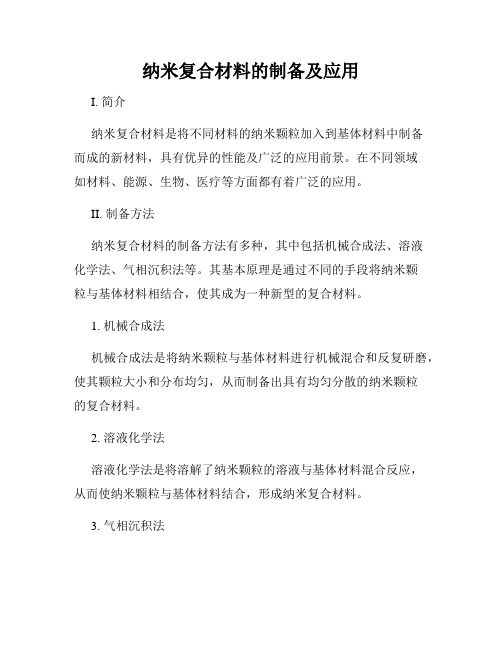
纳米复合材料的制备及应用I. 简介纳米复合材料是将不同材料的纳米颗粒加入到基体材料中制备而成的新材料,具有优异的性能及广泛的应用前景。
在不同领域如材料、能源、生物、医疗等方面都有着广泛的应用。
II. 制备方法纳米复合材料的制备方法有多种,其中包括机械合成法、溶液化学法、气相沉积法等。
其基本原理是通过不同的手段将纳米颗粒与基体材料相结合,使其成为一种新型的复合材料。
1. 机械合成法机械合成法是将纳米颗粒与基体材料进行机械混合和反复研磨,使其颗粒大小和分布均匀,从而制备出具有均匀分散的纳米颗粒的复合材料。
2. 溶液化学法溶液化学法是将溶解了纳米颗粒的溶液与基体材料混合反应,从而使纳米颗粒与基体材料结合,形成纳米复合材料。
3. 气相沉积法气相沉积法主要是在高温高压的条件下,将纳米颗粒与基体材料分别蒸发或气化,并通过反应使其结合,形成纳米复合材料。
III. 应用领域纳米复合材料具有广泛的应用领域,包括以下几个方面:1. 材料领域纳米复合材料在材料领域有着广泛的应用,可以用于制备高强度、高硬度、高温度等方面的新材料,例如纳米硬质材料、纳米粘土复合材料、纳米碳复合材料等。
2. 能源领域纳米复合材料在能源领域也有着广泛的应用前景,可以应用于太阳能电池、燃料电池、超级电容器等方面,以提高其性能表现。
3. 生物领域纳米复合材料在生物领域能够制备出高效的药物、生物传感器、生物医学材料等,其应用范围包括医疗、食品、生物工程等方面。
4. 化学领域纳米复合材料在化学领域也有着广泛的应用前景,例如用于化学催化、分离等方面,以提高效率、减少能量消耗等。
IV. 总结纳米复合材料是一种新型的材料,其制备方法简单、效率高,能够应用于多个领域。
未来,随着技术的不断进步,纳米复合材料的性能和应用领域将会越来越广,成为各个领域的重要组成部分。
纳米复合材料
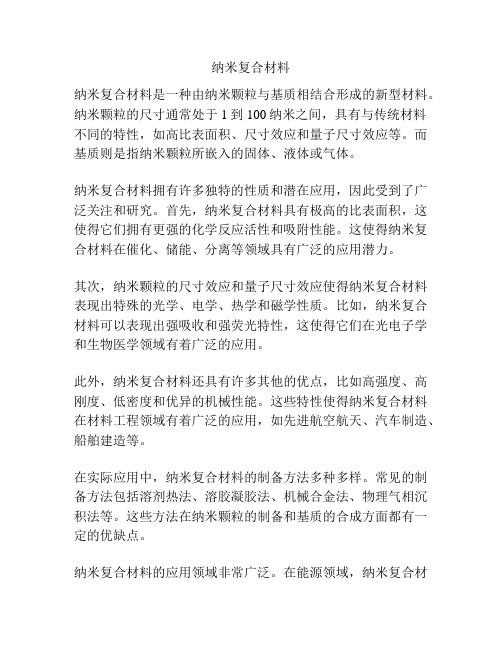
纳米复合材料纳米复合材料是一种由纳米颗粒与基质相结合形成的新型材料。
纳米颗粒的尺寸通常处于1到100纳米之间,具有与传统材料不同的特性,如高比表面积、尺寸效应和量子尺寸效应等。
而基质则是指纳米颗粒所嵌入的固体、液体或气体。
纳米复合材料拥有许多独特的性质和潜在应用,因此受到了广泛关注和研究。
首先,纳米复合材料具有极高的比表面积,这使得它们拥有更强的化学反应活性和吸附性能。
这使得纳米复合材料在催化、储能、分离等领域具有广泛的应用潜力。
其次,纳米颗粒的尺寸效应和量子尺寸效应使得纳米复合材料表现出特殊的光学、电学、热学和磁学性质。
比如,纳米复合材料可以表现出强吸收和强荧光特性,这使得它们在光电子学和生物医学领域有着广泛的应用。
此外,纳米复合材料还具有许多其他的优点,比如高强度、高刚度、低密度和优异的机械性能。
这些特性使得纳米复合材料在材料工程领域有着广泛的应用,如先进航空航天、汽车制造、船舶建造等。
在实际应用中,纳米复合材料的制备方法多种多样。
常见的制备方法包括溶剂热法、溶胶凝胶法、机械合金法、物理气相沉积法等。
这些方法在纳米颗粒的制备和基质的合成方面都有一定的优缺点。
纳米复合材料的应用领域非常广泛。
在能源领域,纳米复合材料被用于制造更高效的太阳能电池、储能装置和燃料电池。
在环境领域,纳米复合材料可用于制造高效的吸附剂、光催化剂和膜分离材料,以净化水和处理废水。
在电子和光电子领域,纳米复合材料可以用于制造更小、更快、更高效的电子器件和光电子器件。
纳米复合材料的研究发展还面临许多挑战和问题。
首先,纳米复合材料的制备方法需要更加精确和可控,以实现复合材料的一致性和稳定性。
其次,纳米复合材料的安全性和环境影响也需要充分考虑。
最后,纳米复合材料的商业化还需要解决成本和规模化生产等问题。
总的来说,纳米复合材料具有广泛的应用潜力,将在各个领域中发挥重要作用。
随着相关技术的不断发展和突破,纳米复合材料将会在未来实现更多的商业化应用,为社会的进步和发展做出重要贡献。
纳米复合材料的制备与性能调控方法介绍
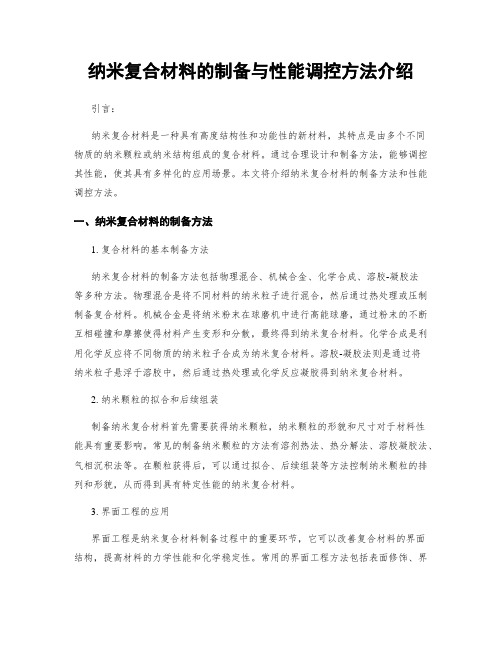
纳米复合材料的制备与性能调控方法介绍引言:纳米复合材料是一种具有高度结构性和功能性的新材料,其特点是由多个不同物质的纳米颗粒或纳米结构组成的复合材料。
通过合理设计和制备方法,能够调控其性能,使其具有多样化的应用场景。
本文将介绍纳米复合材料的制备方法和性能调控方法。
一、纳米复合材料的制备方法1. 复合材料的基本制备方法纳米复合材料的制备方法包括物理混合、机械合金、化学合成、溶胶-凝胶法等多种方法。
物理混合是将不同材料的纳米粒子进行混合,然后通过热处理或压制制备复合材料。
机械合金是将纳米粉末在球磨机中进行高能球磨,通过粉末的不断互相碰撞和摩擦使得材料产生变形和分散,最终得到纳米复合材料。
化学合成是利用化学反应将不同物质的纳米粒子合成为纳米复合材料。
溶胶-凝胶法则是通过将纳米粒子悬浮于溶胶中,然后通过热处理或化学反应凝胶得到纳米复合材料。
2. 纳米颗粒的拟合和后续组装制备纳米复合材料首先需要获得纳米颗粒,纳米颗粒的形貌和尺寸对于材料性能具有重要影响。
常见的制备纳米颗粒的方法有溶剂热法、热分解法、溶胶凝胶法、气相沉积法等。
在颗粒获得后,可以通过拟合、后续组装等方法控制纳米颗粒的排列和形貌,从而得到具有特定性能的纳米复合材料。
3. 界面工程的应用界面工程是纳米复合材料制备过程中的重要环节,它可以改善复合材料的界面结构,提高材料的力学性能和化学稳定性。
常用的界面工程方法包括表面修饰、界面亲和性调控、交联等。
例如,通过改变界面的化学性质、引入有机分子等手段,可以增强纳米颗粒与基体之间的结合,提高复合材料的强度和韧性。
二、纳米复合材料的性能调控方法1. 尺寸效应调控尺寸效应是纳米材料独特的性质之一,通过调控纳米颗粒的尺寸,可以调节材料的光学、电学和力学性能。
当纳米颗粒的尺寸达到纳米级别时,会出现量子尺寸效应,导致材料具有特殊的光学性质。
因此,通过控制纳米颗粒的尺寸,可以实现对纳米复合材料光学、电学等性能的精细调控。
纳米复合材料制备
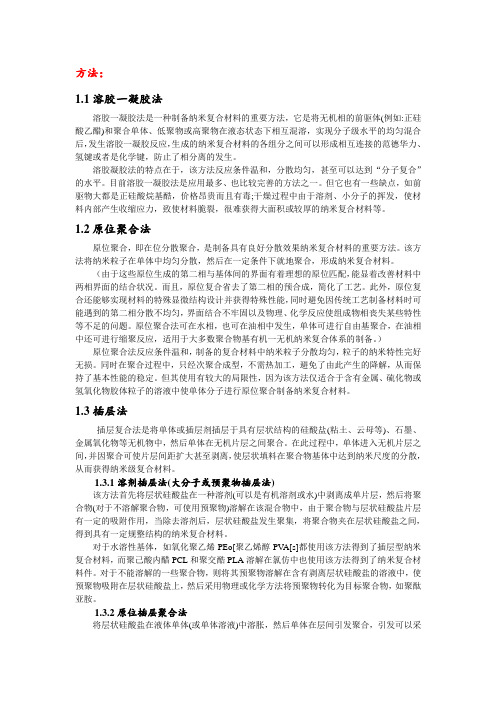
方法:1.1溶胶一凝胶法溶胶一凝胶法是一种制备纳米复合材料的重要方法,它是将无机相的前驱体(例如:正硅酸乙醋)和聚合单体、低聚物或高聚物在液态状态下相互混溶,实现分子级水平的均匀混合后,发生溶胶一凝胶反应,生成的纳米复合材料的各组分之间可以形成相互连接的范德华力、氢键或者是化学键,防止了相分离的发生。
溶胶凝胶法的特点在于,该方法反应条件温和,分散均匀,甚至可以达到“分子复合”的水平。
目前溶胶一凝胶法是应用最多、也比较完善的方法之一。
但它也有一些缺点,如前驱物大都是正硅酸烷基酷,价格昂贵而且有毒;干燥过程中由于溶剂、小分子的挥发,使材料内部产生收缩应力,致使材料脆裂,很难获得大面积或较厚的纳米复合材料等。
1.2原位聚合法原位聚合,即在位分散聚合,是制备具有良好分散效果纳米复合材料的重要方法。
该方法将纳米粒子在单体中均匀分散,然后在一定条件下就地聚合,形成纳米复合材料。
(由于这些原位生成的第二相与基体间的界面有着理想的原位匹配,能显着改善材料中两相界面的结合状况。
而且,原位复合省去了第二相的预合成,简化了工艺。
此外,原位复合还能够实现材料的特殊显微结构设计并获得特殊性能,同时避免因传统工艺制备材料时可能遇到的第二相分散不均匀,界面结合不牢固以及物理、化学反应使组成物相丧失某些特性等不足的问题。
原位聚合法可在水相,也可在油相中发生,单体可进行自由基聚合,在油相中还可进行缩聚反应,适用于大多数聚合物基有机一无机纳米复合体系的制备。
)原位聚合法反应条件温和,制备的复合材料中纳米粒子分散均匀,粒子的纳米特性完好无损。
同时在聚合过程中,只经次聚合成型,不需热加工,避免了由此产生的降解,从而保持了基本性能的稳定。
但其使用有较大的局限性,因为该方法仅适合于含有金属、硫化物或氢氧化物胶体粒子的溶液中使单体分子进行原位聚合制备纳米复合材料。
1.3插层法插层复合法是将单体或插层剂插层于具有层状结构的硅酸盐(粘土、云母等)、石墨、金属氧化物等无机物中,然后单体在无机片层之间聚合。
纳米复合材料的制造工艺

纳米复合材料的制造工艺1. 简介纳米复合材料是一种由纳米粒子和基体材料组成的新型复合材料。
纳米粒子的尺寸通常在1-100纳米之间,具有特殊的物理和化学性质,可以赋予基体材料许多优异的性能。
纳米复合材料的制造工艺是为了在材料制备过程中有效地控制纳米粒子的分散、尺寸和分布等参数,从而得到具有理想性能的材料。
2. 纳米复合材料的制备方法纳米复合材料的制备方法多种多样,包括溶胶-凝胶法、机械合金法、气相沉积法、湿法合成法等。
下面将对其中几种常用的制备方法进行详细介绍。
2.1 溶胶-凝胶法溶胶-凝胶法是一种在溶液中通过化学反应控制纳米粒子的生成和组装过程的制备方法。
其主要步骤包括溶胶制备、凝胶形成和热处理等。
1.溶胶制备:选择合适的溶剂和试剂,在适当的条件下进行反应,得到纳米粒子的前体溶胶。
2.凝胶形成:通过水解、缩聚等反应,使得溶胶发生凝胶反应,生成固体凝胶。
3.热处理:通过热处理,去除凝胶中的有机物,使得纳米粒子形成稳定的网络结构。
溶胶-凝胶法制备的纳米复合材料具有较大的比表面积和均匀的分散度,广泛应用于催化剂、传感器等领域。
2.2 机械合金法机械合金法是一种通过机械力的作用,使不相容的物质混合在一起,并形成纳米复合材料的制备方法。
1.球磨:将纳米粉末和基体材料一起放入球磨仪中,通过球磨的过程,使两种材料发生机械合金反应。
2.热处理:经过球磨后,将混合物进行热处理,消除应力和晶界缺陷,并提高纳米粒子的结晶度。
机械合金法制备的纳米复合材料具有高强度、高硬度和良好的耐磨性,广泛应用于航空航天、汽车制造等领域。
2.3 气相沉积法气相沉积法是一种将气体中的原子或分子沉积到基体材料上,制备纳米复合材料的方法。
1.化学气相沉积:通过化学反应,将气体中的原子或分子沉积到基体材料上。
2.物理气相沉积:通过物理效应(如溅射、蒸发等),将气体中的原子或分子沉积到基体材料上。
气相沉积法制备的纳米复合材料具有良好的均匀性和结晶性,广泛应用于电子器件、光学器件等领域。
- 1、下载文档前请自行甄别文档内容的完整性,平台不提供额外的编辑、内容补充、找答案等附加服务。
- 2、"仅部分预览"的文档,不可在线预览部分如存在完整性等问题,可反馈申请退款(可完整预览的文档不适用该条件!)。
- 3、如文档侵犯您的权益,请联系客服反馈,我们会尽快为您处理(人工客服工作时间:9:00-18:30)。
Polymer intercalation from solution Polymer melt intercalation
to mix the polymer and layered silicate together and then heat the mixture above the glass transition temperature (softening point) of the polymer
聚合物共混改性原理
聚合物共混改性原理
聚合物共混改性原理
The new properties of nanocomposites
Efficient reinforcement with minimal loss of ductility and impact strength Increase thermal stability Increase flame retardant Improved gas barrier properties Improved ionic conductivity Reduced thermal expansion coefficient Altered electronic and optical properties
聚合物共混改性原理
Polymer layered Nanocomposites preparation
In-situ intercalation polymerization
to intercalate the monomer and then take advantage of the host’s oxidising properties to induce polymerization
College of Polymer Science & Engineering
聚合物共混改性原理
———— 聚合物纳米复合材料
张 琴
聚合物共混改性原理
聚合物复合体系的分类
分散相的尺度大小
复合体系 组合
(1)聚合物 /低分子物 (2)聚合物 /聚合物 (3)聚合物 /填充物 宏观相分离 型聚合物掺 混物 聚合物/填充 物复合体系 >1000nm (>1μm) 100~1000nm (0.1~1 μm) 低分子作增容 剂 微观相分离型 聚合物合金 聚合物/填充 物复合体系 1~100nm(0.0 01~0.1 μm, 10~1000Å) 低分子流变改 性剂
聚合物共混改性原理
Degree of biodegradation (i.e. CO2 evolution), and (b)timedependent change of matrix Mw of neat PLA and PLACN4 (MEE clay =4 wt%) under compost at (58 + 2) º C
聚合物共混改性原理
TGA curves for polystyrene, PS and the nanocomposites
聚合物共混改性原理
Proposed model for the torturous zigzag diffusion path in an exfoliated polymer–clay nanocomposite when used as a gas barrier
Exfoliation-adsorption Template synthesis
聚合物共混改性原理
In situ Polymerization
聚合物共混改性原理
Schematic representation of in-situ polymerization
聚合物共混改性原理
聚合物大分子溶液插层工艺示意图
聚合物共混改性原理
Cation-exchange reaction between the silicate and the alkylammonium salt
蒙脱土族矿物具有离子交换性、吸水性、 膨胀性、触变性、黏结性、吸附性等特性
聚合物共混改性原理
插层剂的作用
利用离子交换的原理进入蒙脱土片层之间;
聚合物共混改性原理
湿法生产工艺:
原土
包装
破碎
粉碎
制浆
干燥
提纯
过滤
改型活化
有机覆盖
覆盖剂
干法生产工艺:
原土 包装 制浆 粉碎 提纯1 干燥 提纯2 加热混合 改型活化 精细钠土 覆盖剂
聚合物共混改性原理
Structure of 2:1 layered silicates
蒙脱土的结构特征---天然的纳米结构
Polymer nanocomposites are generally defined as the combination of a polymer matrix resin and inorganic particles (particles, layers or fibres) which have at least one dimension (i.e. length, width, or thickness) in the nanometer size range
聚合物共混改性原理
蒙脱土的化学通式:
Nax(H2O)4{(AL2~xMgx)[Si4O10](OH)2}
分类: 钠基蒙脱土(碱性土) 钙基蒙脱土(碱土性土) 天然漂白土(酸性土)
聚合物共混改性原理
蒙脱土的改性方法
ቤተ መጻሕፍቲ ባይዱ
人工钠化改型(悬浮液法、堆场钠化法、挤压法)
酸活化方法(干法活化工艺、湿法活化工艺)
聚合物共混改性原理
a novel compounding process using Na–montmorillonite water slurry for preparing novel nylon 6/Na–montmorillonite nanocomposites
Naoki Hasegawa, et al, Polymer 44 (2003) 2933–2937
聚合物共混改性原理
What nanocomposites are
Nanocomposites are made by mixing two or more phase, such as particles, layers or fibres, where at least one of the phases is in the nanometre size range. Because the building blocks making up the nanocomposites are therefore so close to the molecular scale, confinement and quantum effects result from the way that the blocks interact. Nanocomposites show properties not found in bulk materials, differentiating them from typical composites or filled-polymer systems.
PP及其纳米复合材料的热释放速率对比 (热通量=35kW/m2)
聚合物共混改性原理
Real picture of biodegradability of neat PLA and PLACN4 recovered from compost with time. Initial shape of the crystallized samples was 3 *10 *0.1 cm3.
聚合物共混改性原理
Schematic representation of melt intercalation
聚合物共混改性原理
Main hopper
Side feeding Devolatilization
Extrudate
聚合物共混改性原理
制备方法的改进
利用共聚物制纳米复合材料(PS、PMMA); 利用聚合物催化剂制纳米复合材料(PS、PET); 利用相容剂制纳米复合材料(PP); 利用环状低聚物的开环聚合制纳米复合材料(PC); 硬质环氧树脂纳米复合材料的制备(硬质环氧树脂)。
聚合物共混改性原理
制备聚合物纳米复合材料的无机物的种类
• 纳米粒子(CaCO3 、SiO2 、 TiO2、ZnO、Al2O3、Cr2O3 )
• 纳米纤维 (碳纳米管、纤维素晶须、凹凸棒土 ) • 层状无机物
聚合物共混改性原理
Layered host crystals susceptible to intercalation by a polymer
聚合物共混改性原理
非聚合物 纳米复合材料
金属/金属
金属/陶瓷
陶瓷/陶瓷 聚合物基 无机物基
纳米复合材料
有机/无机 纳米复合材料 聚合物 纳米复合材料 聚合物/聚合物 纳米复合材料
分子复合 原位复合 微纤/基体
Classification of nanocomposite
聚合物共混改性原理
Polymer/inorganic nanocomposites
聚合物共混改性原理
Naoki Hasegawa, et al, Polymer 44 (2003) 2933–2937
聚合物共混改性原理
Layered Nanocomposite structure
聚合物共混改性原理
聚合物共混改性原理
PLS纳米复合材料微观结构的分类表
聚合物共混改性原理
Schematic depicting the XRD patterns for various types of structures
